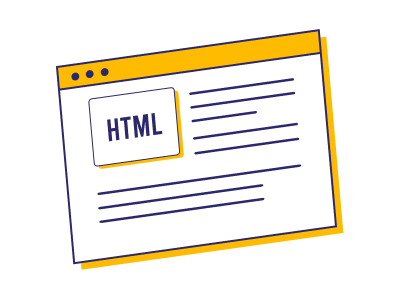Hypertext Mark-up Language, abbreviated as HTML, serves as the standard markup language for crafting web pages. It facilitates the construction and organization of web page components like sections, paragraphs, and links through HTML elements, which include tags and attributes as fundamental building blocks.
Use Cases of HTML include:
Web Development:
Developers utilize HTML code to structure the appearance of web page elements in a browser, encompassing aspects like text, hyperlinks, and media files. After the development, HTML hosting resources are essential.
Internet Navigation:
Effortless navigation and linking between related pages and websites are facilitated by the widespread use of HTML, which allows users to easily embed hyperlinks.
Web Documentation:
HTML easily enables you to organize and format documents just like Microsoft Word.
It’s important to highlight that HTML is not classified as a programming language because it lacks the capability to create dynamic functionality. However, it has attained the status of an official web standard. The World Wide Web Consortium (W3C) is responsible for maintaining and developing HTML specifications, consistently delivering updates.
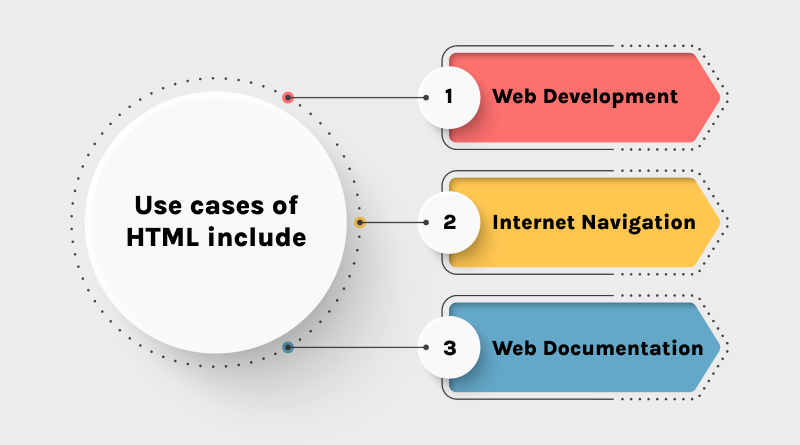
This article covers the fundamental aspects of HTML, exploring its functionality, advantages and disadvantages, and its connections with CSS and JavaScript.
How Does HTML work?
An average website comprises of several HTML pages. For example, the home page, the about us page and the contact us page all these pages are made up of distinct HTML pages.
HTML documents are files with extensions like .html or .htm. When a web browser reads these files, it renders their content, allowing internet users to view the displayed information.
All the HTML pages have a series of HTML elements made of a set of tags and attributes. These HTML elements are the building blocks of a web page. A tag enables the browser to understand where an element begins and ends and an attribute provides information about the characteristics of the element.
The Three Main Parts of An HTML Element Are:
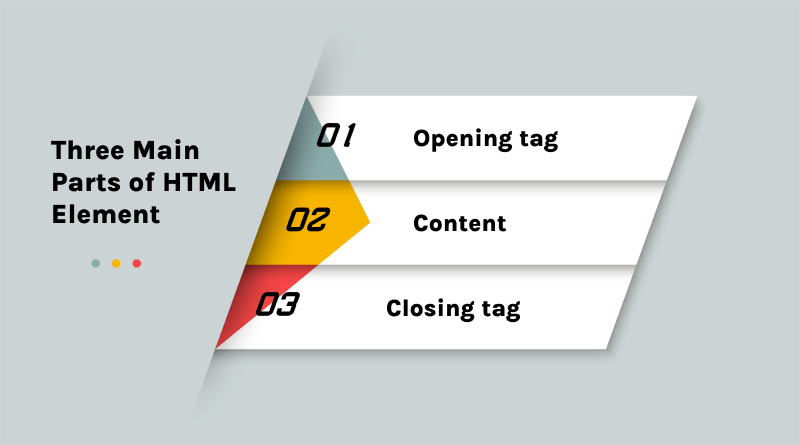
- Opening tag: This tag is used to tell where the element starts to take effect. This tag comprises of opening and closing brackets. For example, you can use the star tag
- <p>
- <p> for creating a paragraph
- Content: The output that is seen by the other users.
- Closing tag: This tag is the same as the opening tag, but it has a forward slash before the element name. For example,
- </p>
- </p> for closing a paragraph
The combination of these three parts creates an element.
This is how you add a paragraph in HTML.
This is how you add a paragraph in HTML.
This is how you add a paragraph in HTML.
An integral aspect of an HTML element is its attribute, divided into two parts – a name and an attribute value. The name indicates the additional information a user intends to include, while the attribute value provides the specifications.
As an illustration, a style element incorporating the colour purple and the font-family Verdana will appear as follows:
Yet another crucial attribute in HTML is the class attribute, particularly significant for development and programming. The class attribute imparts style information that can be applied to various elements sharing the same class value.
For instance, the same style will be used for the heading.
<h1>
<h1> and a paragraph
<p>
<p>. this style comprises of the colour, text colour, border, margin, and padding, under the class .important. for achieving the same style.
<h1>
<h1> and
<p>
<p>, add
class=”important”
class=”important” after every start tag:
While the majority of elements feature both an opening and closing tag, certain elements, known as empty elements, do not require closing tags to function. These elements dispense with an end tag as they lack content.
This image tag is made up of two attributes – an
src
src attribute, image path and an
alt
alt attribute and the descriptive text. However, it does not have any content nor an end tag. Every HTML document should start with a <!DOCTYPE> declaration for informing the web browser about the type of the document. If you use HTML5, the doctype HTML public declaration will be as given below:
<!DOCTYPE html>
Commonly Used HTML Tags and Elements
Presently, there exist 142 HTML tags enabling the formation of diverse elements. Despite the fact that certain tags are no longer supported by modern browsers, acquiring knowledge of the full spectrum of available elements remains advantageous.
In this segment, we will explore the commonly employed HTML tags along with two primary elements: block-level elements and inline elements.
Block-Level Elements
A block-level element occupies the entire width of a page and consistently initiates a new line in the document. For instance, a heading element will appear on a distinct line from a paragraph element.
Every HTML page incorporates these three tags:
- The <html> tag serves as the foundational element that defines the entire HTML document.
- The <head> tag contains metadata, including the page’s title and character set information.
- The <body> tag encompasses all the content displayed on the page.
Other Popularly Used Block-level Tags Include:
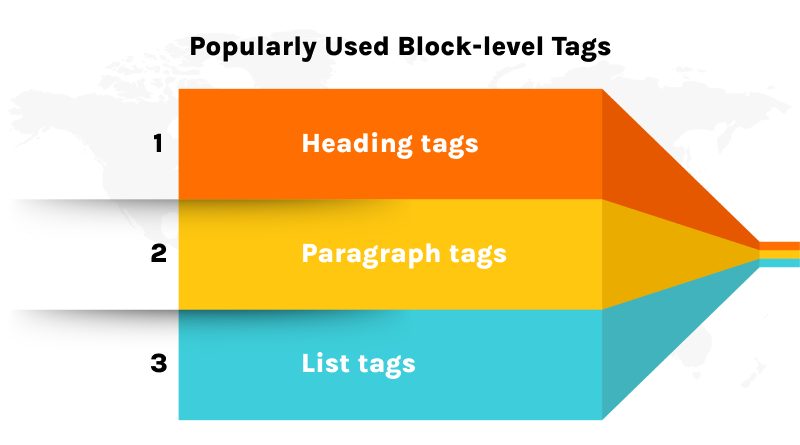
- Heading tags: These span from <h1> to <h6>, with <h1> being the largest in size and progressively decreasing in size up to <h6>.
- Paragraph tags: They are all enclosed with the <p> tag.
- List tags: Come in various forms. Employ the <ol> tag for an ordered list and the <ul> tag for an unordered list. Subsequently, enclose each list item using the <li> tag.
Inline Elements
An inline element styles the internal content of block-level elements, such as incorporating links and emphasizing text. Inline elements are frequently employed to format text without disrupting the continuity of the content.
As an illustration, using the <strong> tag would display an element in bold, while the <em> tag would present it in italics. Hyperlinks, which are also inline elements, utilize the <a> tag and an href attribute to specify the destination of the link:
<a href=”https://example.com/”>Click me!</a>
HTML Evolution: What’s the Different Between HTML and HTML 5?
The initial iteration of HTML comprised 18 tags. Subsequent versions brought about the incorporation of new tags and attributes into the markup. The most notable advancement in the language occurred with the unveiling of HTML5 in 2014.
The primary distinction between HTML and HTML5 lies in HTML5’s support for novel types of form controls. Additionally, HTML5 introduced various semantic tags like <article>, <header>, and <footer> aimed at providing clear descriptions of the content.
Pros and Cons of HTML
Similar to any computer language, HTML possesses both advantages and disadvantages. Here are the strengths and limitations of HTML:
Pros
- Easy for beginners. HTML features a clear and uniform markup, along with a straightforward learning curve.
- Support. The language is extensively employed, supported by ample resources, and boasts a sizable community.
- Accessible. Open-source and entirely cost-free, HTML operates natively in all web browsers.
- Flexible. HTML effortlessly integrates with backend languages like PHP and Node.js.
Cons
- Static. The language is predominantly employed in the creation of static websites. To incorporate dynamic functionality, one might require the use of JavaScript or a backend language like PHP.
- Separate HTML pages. Users need to generate separate HTML web pages for each instance, even when the elements are identical.
- Compatible with browsers. Certain browsers may gradually incorporate new features, and older browsers might not consistently display newer HTML tags.
What is the connection between HTML, CSS and JavaScript?
While HTML serves to introduce text elements and establish content structure, it alone is insufficient for constructing a polished, fully responsive website. To achieve this, HTML relies on Cascading Style Sheets (CSS) and JavaScript to craft the majority of the website’s content.
CSS handles styling aspects like backgrounds, colours, layouts, spacing, and animations, while JavaScript contributes dynamic functionalities such as sliders, pop-ups, and photo galleries. Together, these three languages form the foundational elements of front-end development.
Getting A Deeper Insight Into HTML
Embarking on the journey of web development often begins with acquiring knowledge about HTML.
Numerous online courses teach coding, and we’ve highlighted three premier tutorial for learning HTML:
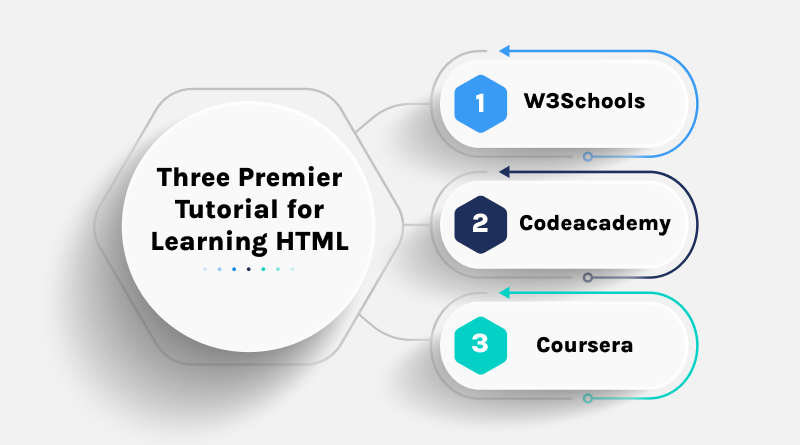
- W3Schools: Offers free resources, examples, and exercises for acquiring fundamental HTML skills. Additionally, there is a self-paced HTML tutorial priced at $95, which includes an official certificate upon completion.
- Codeacademy: They offer beginner courses for free along with interactive tutorials. Codeacademy makes use of a split-screen that automatically displays the result of the coding done on an HTML file. You get exclusive content at $19.99/month.
- Coursera: Presents a range of courses offering comprehensive explanations accompanied by real-life examples. The subscription is priced at $49/month, and there is a 7-day free trial available to begin.
HTML stands as the predominant markup language across the internet. Every HTML page comprises a set of elements that define the content structure for a webpage or application.
HTML is a beginner-friendly language well-supported and primarily employed for static website pages. For optimal results in styling, it collaborates seamlessly with CSS, while JavaScript enhances its functionality. In this blog we have also highlighted the top online courses that can either enhance your proficiency in HTML or offer a fundamental understanding of the language.
FAQs
What is HTML used for?
HTML stands for Hypertext Markup Language. It’s the foundation of creating web pages. Just like bricks build a wall, HTML tags build the structure and layout of a web page.
It defines the basic building blocks of a web page like headings, paragraphs, images, links, and forms. It doesn’t add visuals or styling, but allows other languages like CSS and JavaScript to bring those elements to life.
Is HTML easy to learn?
Yes, HTML is considered one of the easiest programming languages to learn. It’s simple, consistent, and uses plain English keywords for its tags. Even with no prior experience, you can grasp the basics quickly.
How long does it take to learn HTML?
The time it takes to learn HTML depends on your learning style and dedication. For a basic understanding of creating simple web pages, you can get started in a few hours or days. To achieve a more advanced level with complex layouts and functionality, it might take weeks or months of practice.
Where can I learn HTML?
There are many resources available for learning HTML online and offline:
1. Online courses and tutorials: Numerous platforms like Codecademy, Khan Academy, W3Schools, and Coursera offer interactive courses and tutorials for beginners and advanced learners.
2. Books and ebooks: Many excellent books like “Head First HTML and CSS” or “HTML & CSS: Design and Build Websites” provide comprehensive explanations and exercises.
3. YouTube channels: Learn through engaging video tutorials on channels like The Net Ninja, Traversy Media, and freeCodeCamp.
4. Websites and blogs: Websites and learning tutorials offer extensive documentation and references for all HTML tags and attributes.

